

Caption: It’s a temptation to play with the sliding doors of a KF-161. Each travels on a metal rail that is part of the car’s frame. As you can see, the driver sits mighty close to the ground.
Hi Gang…
More neat stuff to share about the debut of the Kaiser Darrin….
Darren Swanson and I are working on an exact timeframe for all of the details of the debut of the Kaiser Darrin. We’re also working with folks from the Kaiser-Frazer club, so we should have some excellent details to share with you in the near future.
Today’s article is a bridge – it represents information shared with the public between the initial announcement of the building of the Darrin in early 1953 and the final delivery of the cars to the public in early 1954 – even though the article predicts that the cars will be available earlier – July 1953.
The article below appeared in the May 1953 issue of Popular Science. Let’s have a look at what was shared inside:
Plastic Henry J (Popular Science, May 1953)
Makes Play For Sports Car Fans
Kaiser-Frazer’s new “show-off,” with the European look, weighs 1500 pounds less than the lightest steel-body U.S. convertible.
Many an eye will blink in wonder and admiration when Kaiser-Frazer’s dazzling bid for the sports-car market appears on the nation’s highways in July. Howard Darrin, its noted designer, believes the American public longs for “show-off” cars. The KF-161 is a show-off in practically every respect, from plastic body to beefed-up engine.
It is as low as a racing car – 36 inches from ground to cowl, only 54 inches to the crown of its fold-away top – and nearly as fast. Its top speed is over 100 miles an hour, the exact figure depending on who is driving. It takes off like a rocket, whisking from 10 to 70 miles an hour in high gear in 15 seconds.

Caption: Light shows through the glass-fiber reinforced plastic body in its unpainted state, when it resembles animal horn. The darker hued rear end has been given priming coat.
Its power plant is a six-cylinder Henry J engine souped up, with high compression head, three carburetors in line, a modified camshaft and dual exhausts, to provide better than 100 horsepower. The “161” in its name is for piston displacement. Compression ratio is 8:1.
The KF-161’s speed and swift get-away are partly the result of increased power, partly of reduced weight. It is the first car with a body of glass fiber reinforced plastic to be produced in quantity Its body weighs only 300 pounds, enabling the completed car to tip the scales at a fraction over a ton, or about 1500 pounds less than the lightest steel-body U.S. convertible. The weight-to-power ratio is 22 pounds.
The car’s body is molded in seven parts: front end, rear end, hood, rear-deck lid, doors, and floor. The parts that fasten to the frame are bolted to it. The parts that, like the hood, fasten to other plastic parts, are hinged. Sections where bolts pass through the plastic shell are built up to provide extra strength. The hood, by the way, opens along its right-hand side.
Darrin believes that since the number of foreign sports cars registered in the U.S. has doubled in the last three years, there’s a lively potential demand for an American car of the same general heft, size, look, and speed. The KF-161, which is 15.3 feet long, is exceedingly graceful and has a minimum of “gook.”
That is the word which true sports-car fans use to describe all hydraulically operated gadgets, chromium decorations, power steering, automatic transmissions and riding comfort.
Has Typical Hard Sports-Car Ride:
The KF-161’s ride is hard, as the lover of sports cars thinks it should be. The steering and shifting are standard. There’s almost no chrome work. The doors – a brand-new note – slide into the front fender cavities instead of opening out, but you have to slide them yourself.
Even the wire wheels, which add so much swank to the car’s appearance, are optional. Because of its exceptionally low center of gravity, the car corners beautifully and clings to the road. It has 132 square inches of braking surface to restrain an eager foot at the accelerator.
The price – not yet firmly decided – is rumored to be under $3000. Wesley S. Griswold
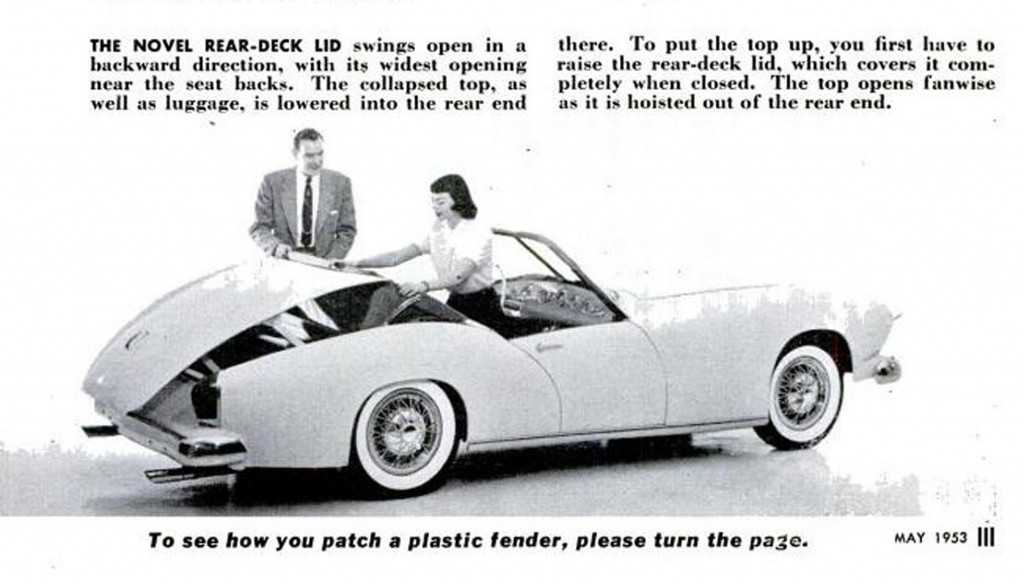
Caption: The novel rear-deck lid swings open in a backward direction, with its widest opening near the seat backs. The collapsed top, as well as luggage, is lowered into the rear end there. To put the top up, you first have to raise the rear-deck lid, which covers it completely when closed. The top opens fanwise as it is hoisted out of the rear end.
Summary:
Pretty cool car gang – and one that owes its origins to Bill Tritt and a donated / purchased Glasspar G2 – as relayed to me by Bill Tritt. But more about that in a future story here at Forgotten Fiberglass 🙂
Hope you enjoyed the story, and until next time…
Glass on gang…
Geoff
——————————————————————-
Click on the Images Below to View Larger Pictures
——————————————————————-
- Caption: Light shows through the glass-fiber reinforced plastic body in its unpainted state, when it resembles animal horn. The darker hued rear end has been given priming coat.
- Caption: It’s a temptation to play with the sliding doors of a KF-161. Each travels on a metal rail that is part of the car’s frame. As you can see, the driver sits mighty close to the ground.
- Caption: The novel rear-deck lid swings open in a backward direction, with its widest opening near the seat backs. The collapsed top, as well as luggage, is lowered into the rear end there. To put the top up, you first have to raise the rear-deck lid, which covers it completely when closed. The top opens fanwise as it is hoisted out of the rear end.


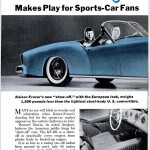
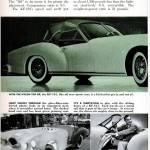
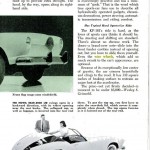
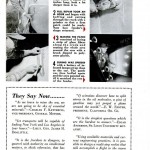





This site is protected by reCAPTCHA and the Google Privacy Policy and Terms of Service apply.